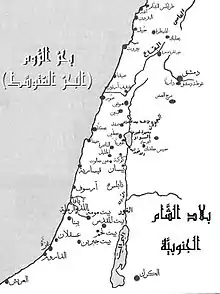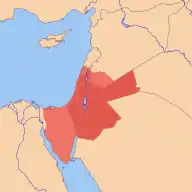جنوب بلاد الشام
جنوب بلاد الشام هي المنطقة الجغرافية التي تشمل النصف الجنوبي من بلاد الشام. وهي تطابق تقريبا في العصر الحديث فلسطين التاريخية والأردن. وتشمل بعض التعاريف أيضا جنوب لبنان، جنوب سوريا و/أو شبه جزيرة سيناء.[1] كما وصف الجغرافي بدقة، ويستخدم في بعض الأحيان من قبل علماء الآثار والمؤرخين لتجنب الدلالات الدينية والسياسية للأسماء الأخرى للمنطقة.[2][3]

تشبه إلى حد كبير من جنوب غربي آسيا، جنوب بلاد الشام هي منطقة قاحلة تتكون في الغالب من الصحراء والسهوب الجافة، مع شريط رفيع من الرطوبة والمناخ المعتدل على طول ساحل البحر الأبيض المتوسط. من الناحية الجغرافية يهيمن عليها وادي الأردن، وقسم من وادي الصدع العظيم تتوسط المنطقة من الشمال إلى الجنوب، والتي تحتوي على بحيرة طبريا، نهر الأردن والبحر الميت - أخفض نقطة على سطح اليابسة على الأرض.
جنوب بلاد الشام لديها تاريخ طويل وهي واحدة من المناطق الأكثر بحثاً من قبل علماء أثار العالم. وتعتبر من المرجح أن تكون في المقام الأول من كلا البشر في وقت مبكرة والإنسان الحديث الذين استوطنوا خارج أفريقيا. وبالتالي لديها أثار غنية من العصر الحجري، تعود إلى وقت مبكر قبل 1.5 مليون سنة.
مصطلحات

تشير بلاد جنوب الشام إلى النصف السفلي من بلاد الشام ولكن هناك بعض التباين في التعريف الجغرافي،[4][5] مع تعريف أوسع بما في ذلك فلسطين التاريخة والأردن ولبنان وجنوب سوريا وصحراء سيناء. في مجال علم الآثار جنوب بلاد الشام هي "المنطقة التي تم تحديدها سابقا باسم سوريا وفلسطين وبما في ذلك الكنعان.[6][7]
الجغرافية
تقع جنوب بلاد الشام على الساحل الشرقي للبحر الأبيض المتوسط، في الشرق الأدنى والشرق الأوسط أو غرب أو جنوب آسيا. يحدها من الشرق والجنوب الشرقي والجنوب الغربي من الصحراء السورية والصحراء العربية وشبه جزيرة سيناء. وتشمل بعض التعاريف أجزاء من هذه الصحاري في المنطقة. ويعتبر نهر الليطاني عادة على الخط الفاصل بين جنوب بلاد الشام وشمال بلاد الشام (أي سوريا)، أو في بعض الأحيان نهر العاصي، وفي وسط لبنان أيضا.[3]
الاكتشافات الأثرية
تعتبر الآثار في جنوب بلاد الشام عموما على شكل سلسلة من المراحل أو مراحل في التنمية الثقافية والتطور الانسان، بالنسبة للجزء الأكبر، على الأدوات التكنولوجيا لفترات مبكرة ما قبل التاريخ.[8]
انظر أيضًا
مراجع
- Ziv, Baruch; Dayan, Uri; Kushnir, Yohanan; Roth, Chaggi; Enzel, Yehouda (2006-01-01). "Regional and global atmospheric patterns governing rainfall in the southern Levant". International Journal of Climatology (باللغة الإنجليزية). 26 (1): 55–73. doi:10.1002/joc.1238. ISSN 1097-0088. مؤرشف من الأصل في 17 أغسطس 2016. الوسيط
|CitationClass=تم تجاهله (مساعدة) - Orni, Efraim; Efrat, Elisha (1971). Geography of Israel (الطبعة 3rd). American Heritage Press. ISBN 0070477019. الوسيط
|CitationClass=تم تجاهله (مساعدة) - Ziv, Baruch; Saaroni, Hadas; Pargament, Roee; Harpaz, Tzvi; Alpert, Pinhas (2013-02-22). "Trends in rainfall regime over Israel, 1975–2010, and their relationship to large-scale variability". Regional Environmental Change (باللغة الإنجليزية). 14 (5): 1751–1764. doi:10.1007/s10113-013-0414-x. ISSN 1436-3798. مؤرشف من الأصل في 13 يونيو 2019. الوسيط
|CitationClass=تم تجاهله (مساعدة) - de Geus, C. H. J. (2003). Towns in Ancient Israel and in the Southern Levant. Peeters Publishers. صفحة 6. ISBN 9789042912694. مؤرشف من الأصل في 11 أكتوبر 2017.
At the beginning of this Introduction I have indicated how difficult it is to choose a general accepted name for the region this book deals with. In Europe we are used to the late Roman name 'Palestine,' and the designation 'Palestinian Archaeology' has a long history. According to Byzantine usage it included CisJordan and TransJordan and even Lebanon and Sinai. In modern times, however, the name 'Palestine' has exclusively become the political designation for a restricted area. Furthermore, in the period this book deals with a region called 'Palestine' did not yet exist. Also the ancient name 'Canaan' cannot be used as it refers to an older period in history. Designations as: 'The Land(s) of the Bible' or 'the Hold Land' evoke the suspicion of a theological bias. 'The Land of Israel' does not apply to the situation because it never included Lebanon or the greater part of modern Jordan. Therefore I have joined those who today advocate the designation 'Southern Levant.' Although I confess that it is an awkward name, it is at least strictly geographical.
الوسيط|CitationClass=تم تجاهله (مساعدة) - Arnold, Bill T. (2014). Introduction to the Old Testament. Cambridge: Cambridge University Press. صفحة 37. ISBN 9780521879651. مؤرشف من الأصل في 17 سبتمبر 2016.
What we call the land of the Bible today has potential for misunderstanding. This small strip of land in the Southern Levant has been occupied by so many, fought over and carved up so many times, that it is hard to know just what to call it. The use of 'Israel' implies to some that all of it belongs today only to the Jews as legitimate descendants of OT Israel. Similarly, 'Palestine' has a longstanding usage, but may imply that all of it belongs to Palestinian Arabs exclusively. Both of these terms could be used strictly for geography. But because of the contemporary Israeli-Palestinian conflict, both terms also may introduce misunderstanding. And biblical scholars have no universal agreement on this topic. 'Syria-Palestine' is often used, as here, for geographical precision. But it is only the southern portion of Syria-Palestine that was occupied by ancient Israel, and it does not always communicate sufficiently. 'Canaan' is an ancient name, but it also is not exactly conterminous with the land occupied by ancient Israel. I have used 'Southern Levant' occasionally here but admit that this is a strange expression. l will most often refer simply to 'Israel,' by which I mean the territory of national Israel in the OT, but hope the reader will understand no modern political claims by this use.
الوسيط|CitationClass=تم تجاهله (مساعدة) - Burke, Aaron A. (2016). "The Transformation of Biblical and Syro-Palestinian Archaeology". In Levy, Thomas Evan (المحرر). Historical Biblical Archaeology and the Future: The New Pragmatism (باللغة الإنجليزية). Routledge. ISBN 9781134937530. مؤرشف من الأصل في 29 يوليو 2017.
Much work continues to be done in these regions, and not surprisingly this work is now of great interest to those studying the southern Levant (i.e. the region formerly identified as Syria-Palestine and including Canaan) [...] Nevertheless, despite such a well-reasoned basis for the identification of Levantine archaeology, the adoption of this term by many scholars has been, for the most part, simply the result of individual attempts to consider a wider, yet relevant, cultural corpus than that which is suggested by the use of terms like Canaan,Israel, or even Syria-Palestine. Regardless of the manner in which the term has come into common use, for a couple of additional reasons it seems clear that the Levant will remain the term of choice. In the first place scholars have shown a penchant for the term Levant, despite the fact that the term ‘Syria-Palestine’ has been advocated since the late 1970s. This is evident from the fact that no journal or series today has adopted a title that includes ‘Syria-Palestine’. However, the journal Levant has been published since 1969 and since 1990 Ägypten und Levante has also attracted a plethora of papers relating to the archaeology of this region. Furthermore, a search through any electronic database of titles reveals an overwhelming adoption of the term ‘Levant’ when compared to ‘Syria-Palestine’ for archaeological studies. Undoubtedly, this is mostly due to the fact that ‘Syria-Palestine’ is, correctly speaking, the title for a Roman administrative division of the Levant created by Hadrian (Millar 1993). The term ‘Syria-Palestine’ also carries political overtones that inadvertently evoke current efforts to establish a full-fledged Palestinian state. Scholars have recognized, therefore, that—for at least the time being—they can spare themselves further headaches by adopting the term Levant to identify this region.
الوسيط|CitationClass=تم تجاهله (مساعدة) - "Note éditoriale" [Editorial remarks]. Paléorient. 19 (1). 1993. مؤرشف من الأصل في 09 أكتوبر 2019.
In gathering contributions for the present issue, it soon became apparent - and this is a generally valid point - that imprecise terminology is one of the major difficulties encountered in our research. An example is the term "Southern Levant" used as a substitute for the geographers’ "Palestine". The use of this term hides the particularism of the regions on either side of the Jordan Valley just when the discoveries of the last decade have highlighted their specificity. The lack of precision traditional terminology (agriculture, herding, pastoralism, neolithic, etc.) applied to the complex phenomena that we are studying constantly leads to misunderstandings.
الوسيط|CitationClass=تم تجاهله (مساعدة) - "A passion for cultural difference. Archaeology and ethnicity in the southern Levant". www.academia.edu. مؤرشف من الأصل في 16 ديسمبر 2019. اطلع عليه بتاريخ 26 أبريل 2016. الوسيط
|CitationClass=تم تجاهله (مساعدة)
- بوابة الشام
- بوابة فلسطين
- بوابة الأردن
- بوابة سوريا
- بوابة لبنان
- بوابة الشرق الأوسط
- بوابة الوطن العربي
- بوابة المتوسط
- بوابة الشرق الأوسط القديم

